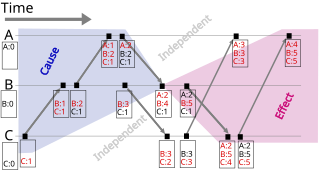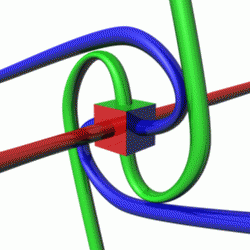Related Research Articles
In modern context Bra and Ket notation can be compared to modern row and column vectors with complex components. Matrix multiplication rules apply with a result usually of more than one row and column. Vector inside and outside products are also following modern rules. Paul Dirac invented the notation Bra and Ket before the present notation of row and column vectors was developed. The complex components are useful in deriving wave functions such as solutions to the Schrödinger equation and in making probability calculations for particle location or momentum in quantum mechanics. Bra and Ket notation is still used in describing quantum mechanics.

Linear algebra is the branch of mathematics concerning linear equations such as:
Routing is the process of selecting a path for traffic in a network or between or across multiple networks. Broadly, routing is performed in many types of networks, including circuit-switched networks, such as the public switched telephone network (PSTN), and computer networks, such as the Internet.

In physics, spacetime is a mathematical model that combines the three dimensions of space and one dimension of time into a single four-dimensional manifold. Spacetime diagrams can be used to visualize relativistic effects, such as why different observers perceive differently where and when events occur.

In mathematics, and more specifically in linear algebra, a linear subspace, also known as a vector subspace is a vector space that is a subset of some larger vector space. A linear subspace is usually simply called a subspace when the context serves to distinguish it from other types of subspaces.

Quantum superposition is a fundamental principle of quantum mechanics. In classical mechanics, things like position or momentum are always well defined. We may not know what they are at any given time, but that is an issue of our understanding, and not the physical system. In quantum mechanics, a particle can be in a superposition of different states. It can be in two places at once. A measurement always finds it in one state, but before and after the measurement, it interacts in ways that can only be explained by having a superpositions of different states.

I2C (Inter-Integrated Circuit; pronounced as “eye-squared-C”), alternatively known as I2C or IIC, is a synchronous, multi-master/multi-slave (controller/target), packet switched, single-ended, serial communication bus invented in 1982 by Philips Semiconductors. It is widely used for attaching lower-speed peripheral ICs to processors and microcontrollers in short-distance, intra-board communication.

In linear algebra, the singular value decomposition (SVD) is a factorization of a real or complex matrix. It generalizes the eigendecomposition of a square normal matrix with an orthonormal eigenbasis to any matrix. It is related to the polar decomposition.
In mathematics, a stochastic matrix is a square matrix used to describe the transitions of a Markov chain. Each of its entries is a nonnegative real number representing a probability. It is also called a probability matrix, transition matrix, substitution matrix, or Markov matrix. The stochastic matrix was first developed by Andrey Markov at the beginning of the 20th century, and has found use throughout a wide variety of scientific fields, including probability theory, statistics, mathematical finance and linear algebra, as well as computer science and population genetics. There are several different definitions and types of stochastic matrices:
The Serial Peripheral Interface (SPI) is a synchronous serial communication interface specification used for short-distance communication, primarily in embedded systems. The interface was developed by Motorola in the mid-1980s and has become a de facto standard. Typical applications include Secure Digital cards and liquid crystal displays.

A vector clock is a data structure used for determining the partial ordering of events in a distributed system and detecting causality violations. Just as in Lamport timestamps, inter-process messages contain the state of the sending process's logical clock. A vector clock of a system of N processes is an array/vector of N logical clocks, one clock per process; a local "largest possible values" copy of the global clock-array is kept in each process.
A logical clock is a mechanism for capturing chronological and causal relationships in a distributed system. Often, distributed systems may have no physically synchronous global clock. In many applications, if two processes never interact, the lack of synchronization is unobservable and in these applications it is enough for the processes to agree on the event ordering rather than the wall-clock time. The first logical clock implementation, the Lamport timestamps, was proposed by Leslie Lamport in 1978.

A scoreboard is a large board for publicly displaying the score in a game. Most levels of sport from high school and above use at least one scoreboard for keeping score, measuring time, and displaying statistics. Scoreboards in the past used a mechanical clock and numeral cards to display the score. When a point was made, a person would put the appropriate digits on a hook. Most modern scoreboards use electromechanical or electronic means of displaying the score. In these, digits are often composed of large dot-matrix or seven-segment displays made of incandescent bulbs, light-emitting diodes, or electromechanical flip segments. An official or neutral person will operate the scoreboard, using a control panel.
In linear algebra, an eigenvector or characteristic vector of a linear transformation is a nonzero vector that changes at most by a scalar factor when that linear transformation is applied to it. The corresponding eigenvalue, often denoted by , is the factor by which the eigenvector is scaled.
The Lamport timestamp algorithm is a simple logical clock algorithm used to determine the order of events in a distributed computer system. As different nodes or processes will typically not be perfectly synchronized, this algorithm is used to provide a partial ordering of events with minimal overhead, and conceptually provide a starting point for the more advanced vector clock method. The algorithm is named after its creator, Leslie Lamport.
In quantum computing, quantum finite automata (QFA) or quantum state machines are a quantum analog of probabilistic automata or a Markov decision process. They provide a mathematical abstraction of real-world quantum computers. Several types of automata may be defined, including measure-once and measure-many automata. Quantum finite automata can also be understood as the quantization of subshifts of finite type, or as a quantization of Markov chains. QFAs are, in turn, special cases of geometric finite automata or topological finite automata.
In quantum physics, unitarity is the condition that the time evolution of a quantum state according to the Schrödinger equation is mathematically represented by a unitary operator. This is typically taken as an axiom or basic postulate of quantum mechanics, while generalizations of or departures from unitarity are part of speculations about theories that may go beyond quantum mechanics. A unitarity bound is any inequality that follows from the unitarity of the evolution operator, i.e. from the statement that time evolution preserves inner products in Hilbert space.

In mathematics and physics, the notion of orientation entanglement is sometimes used to develop intuition relating to the geometry of spinors or alternatively as a concrete realization of the failure of the special orthogonal groups to be simply connected.
In quantum physics, a quantum state is a mathematical entity that provides a probability distribution for the outcomes of each possible measurement on a system. Knowledge of the quantum state together with the rules for the system's evolution in time exhausts all that can be predicted about the system's behavior. A mixture of quantum states is again a quantum state. Quantum states that cannot be written as a mixture of other states are called pure quantum states, while all other states are called mixed quantum states. A pure quantum state can be represented by a ray in a Hilbert space over the complex numbers, while mixed states are represented by density matrices, which are positive semidefinite operators that act on Hilbert spaces.

Matrix is an open standard and communication protocol for real-time communication. It aims to make real-time communication work seamlessly between different service providers, in the way that standard Simple Mail Transfer Protocol email currently does for store-and-forward email service, by allowing users with accounts at one communications service provider to communicate with users of a different service provider via online chat, voice over IP, and videotelephony. It therefore serves a similar purpose to protocols like XMPP, but is not based on any existing communication protocol.
References
- ↑ Drummond, Lúcia M. A.; Barbosa, Valmir C. (2003). "On reducing the complexity of matrix clocks". Parallel Computing. 29 (7): 895–905. arXiv: cs/0309042 . doi:10.1016/S0167-8191(03)00066-8. S2CID 269009.